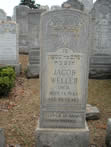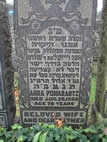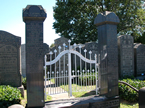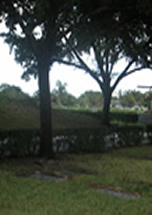CEMETERY & YARZHEIT INFORMATION
ÜKnown Cemetery & Yarzheit Details
Yarzheit
Yarzheit is the Yiddish word for the anniversary of a person's death. Literally it is a composite of two German words Yahr (year) and Zeit (time).
The yarzheit has spiritual significance because it is the day the soul נשמה (neshama) left this physical world and entered the spiritual world. A fundamental belief of Judaism is that this physical world is just a transition world for the Spirit world. Our soul lived before we came to this world and continues to live after this life.
![]()
This world is just a corridor in front of the next world
Prepare yourself in the hallway before you enter the main hall.
(Rebbi Yaakov: Ethics of Fathers chapter 4, verse 21)
According to Jewish tradition, each year on the yarzheit the soul is elevated to a higher level in the spiritual world. Elevation may mean further testing and pain for the soul, so the family remaining on earth asks for an עילוּי נשמה (iloy neshama) ,a peaceful elevation of the soul. This is achieved through saying prayers such as kaddish and psalms, learning mishnayos, lighting candles, praying at the graveside and thinking of the person's good deeds and accomplishments while in the physical world.Traditional Burial and Mourning Customs
In Jewish tradition, a person is buried within twenty-four hours of death. Following the burial is a period of mourning for seven days, known as "the shiva". During this time, close relatives stay at home to receive friends and relatives who come topay their respects to the family. The immediate family does not go to work in the shiva week. They light candles and say prayers at home. NOTE: Nowadays, many Jews opt for their own variations of these customs.
A candle is symbolic of the soul. Throughout the ages, a candle has symbolized the burning bush that Moses saw in the wilderness when God first appeared to him. Also, there is the ner tamid – the everlasting light customarily lit in every synagogue. Just as a candle burns with a lovely peaceful glow, turning itself into energy and then disappearing into the air, so too does the soul pass away from this world when it no longer needs a physical body.
The thirty days after death are called the sheloshim - a traditional mourning period. Anytime after the sheloshim period is over, (customarily within a year) the gravestone is erected. The Kaddish prayer is said daily for eleven months, although some people say it for a whole year less one day. Thereafter, every year on the day of death, the yarzheit is observed.
Reading Hebrew Tombstones
The matzeva, or Jewish gravestone, is often a source of important genealogical information. Jewish tombstones with Hebrew inscriptions are especially helpful as they not only show the date of death and sometimes the age or date of birth, but they also include the given name of the deceased's father, enabling you to go back one more generation. Here are a few helpful pointers if you cannot read Hebrew:
At the top of most Jewish tombstones is the abbreviation that follows![]()
![]() :
:
This stands for po nikbar or po nitman, meaning "here lies".
At the end of many Hebrew tombstone inscriptions you will find the abbreviation that follows: ![]()
![]()
![]()
![]()
![]()
This is an abbreviation of a verse from the Bible from the first book of Samuel, 25:29, "May his soul be bound up in the bond of eternal life".
If any Hebrew characters at all are written on a tombstone, they are most likely to be the person's Hebrew name. A Hebrew name always includes a patronymic, the given name of the deceased's father. This is a unique feature of Jewish tombstones, and a great boon to Jewish genealogy. The Hebrew word ben, means "son of", as in Yaakov ben Yitzhak, meaning "Yaakov the son of Yitzhak". Bat, means "daughter of." On tombstones these words will often appear as an abbreviation for ben reb, meaning "son (or daughter) of the worthy," followed by the father's given name. The word reb is a simple honorific, a title of respect. It does NOT mean Rabbi.
The Jewish Calendar
Dates are written in Hebrew according to the Jewish calendar. This calendar, that starts its "year one" with the Creation of the World, was probably the work of the patriarch Hillel II in the fourth century. He calculated the age of the world by computing the literal ages of biblical characters and other events in the Bible and determined that it began 3760 years before the Christian calendar.
Each letter of the Hebrew Alphabet each has a numerical value, specified in the chart below. When a Hebrew date is written, you must figure out the numerical value of each letter and then add them up. This is the date according to the Jewish calendar, not the calendar we use every day, known as the Gregorian calendar (also referred to as the Common Era, civil or Christian calendar). In September 1999, for example, the Jewish year was 5759. Given a Hebrew date, you need to do only a little bit of math to change the Hebrew year into a secular year.
Often a Hebrew date after the year 5000 on the Jewish calendar will leave off five thousand. For example, the Hebrew year 5680 will be written as 680 rather than 5680. To compute the Gregorian or civil year, add the number 1240 to the shortened Hebrew year.
Here's one example: If the year is written as:
![]()
![]()
![]()
![]()
the first letter (right to left) is 400, the second letter is 200, the third is 80, and the fourth is 3. 400 + 200 + 80 + 3 = 683. When 5000 is added, the actual year is 5683. By using our formula, 683 plus 1240 is 1923. That is the civil or secular year.
The Hebrew year begins on Rosh Hashanah, which occurs on the Gregorian calendar in September or October. Therefore, the dates listed for the months of Tishri, Heshvan, Kislev and sometimes Tevet must be read as applying to the preceding year of the civil calendar.
Hebrew Abbreviations on Tombstones
There are many different Hebrew abbreviations found in tombstone inscriptions and Hebrew literature. Abbreviations are usually indicated by a quotation mark or an apostrophe. Often, the apostrophe is used to abbreviate a single word, whereas the quotation mark indicates an abbreviated phrase.
Symbols on Tombstones
Symbols on the tombstone offer additional clues. Two hands, with four fingers each divided into two sets of two fingers, is the symbol of a priestly blessing, signifying a Kohen, a descendant of Aaron. A pitcher signifies a Levite because the Levites were responsible for cleaning the hands of the Temple priest in ancient days. A candle or candelabra often is used on the tombstone of a woman, and the six-pointed Star of David on that of a man. A tombstone with the motif of a broken branch or tree stump often signifies someone who died young.
Translations of common Hebrew and Yiddish words used
in landsmanshaftn and burial society names
Achei ..... brothers, brethren of
Anshei ..... people of (men of)
Achim ..... brothers, brethren of
Ahuvim ..... beloved
Adath ..... community, congregation
Agudath ..... congregation, union
Ahavath ..... love
Atereth ..... glory, crown
Adam ..... man
Am ..... people, folk
Adereth ..... glory, strength, cloak
Agudath Achim ..... fraternal association
Bnai .... sons of, children of
Beth ..... house
Bikur Cholim ..... sick benefit
Brith ..... alliance
Bakesh ..... seeker
Bachurim ..... young men
Bina ..... understanding
Beth Haknesseth ..... synagogue
Chevra ..... assoc., society
Chachanim ..... wise men, sages
Chaverim ..... comrades, friends
Chesed ..... grace
Chayim ..... life
Chasidim ..... pious men
Chachmath ..... wisdom of
Chadash ..... new
Chasidei ..... pious men of
Chovevei ..... lovers of
Chevra Kadisha ..... burial society
Chafetz ..... desire, love
Degel ..... flag, banner
Dorshei Tov ..... seekers of goodness
Derech Emuna ..... path of faith
Darchei ..... paths of
El ..... G-d
Emeth ..... truth
Etz ..... tree
Ezrath ..... help of, aid of
Emunath ..... faith of, religion of
Eretz ...... land
Gan ..... garden
Gadol ..... big, large
Gemilath Chasadim ..... loan society
Ha ..... the
K.U.V...... Sick Benevolent Society
K'hal ..... community of
Kneseth ..... congregation, gathering, assembly
Kadesh ..... holy
Kadosha ..... holy (female)
Kehilath ..... community, congregation
Kochav ..... star
Kolel ..... community
Kehuna ..... priesthood
Kolel ..... alliance
Kesser ..... crown
L'..... to
Lecheth ...... path
Linath Hatzedek ...... visiting the sick
Lavan ..... white
M' ..... from, of
Machne ..... camp
Magen ..... shield
Mishnayoth ...... commentaries (biblical)
Midrash ..... learning, study
Moshav ..... home
Mesilath ..... path
Minhag ..... manner, custom, ritual
Mishkan ..... dwelling, tabernacle
Machzikei Hadath ...... supporters of the faith
Mesifta ..... high school
Nusach ..... ritual
Ner ..... light
Nachlath ..... inheritance
Netzach ..... preserve
Ohel ..... tent
Or Hashamayin ..... light of the heavens
Ohavei Shalom ..... lovers of peace
Orach ..... path
Omdei ..... those who stand in
Ohev ..... lover
Pitchei.... doors of, gates of
Poalei Tzedek ..... workers of righteousness
Reb, Rav ..... rabbi
Rabenu ..... our rabbi
Rodfei Shalom ..... pursuers of peace
Reim ..... friends
Shalom ..... peace
Sfard ..... Sephardic
Shel ..... of, from
Shearith ..... remnant
Shomrei ..... observers of/keepers of
Shabath ..... Sabbath
Shaarei Torah ..... gates of the law
Shevet ..... tribe
Sheveth ..... congregation
Tomchei ..... supporters
Tamid ..... eternal
Torah ..... law, Bible
Tefila ..... prayer
Teshuva ..... repentance
Tzedek ..... righteousness
Tifereth ..... glory, splendor
Tehilim ..... psalms
Toldoth ..... generation, descendants
Tikvath ..... hope
Tzeirei ..... young people of
Tzemach ..... plant
V' ..... and
Vaad ..... a group, society
Yeshurun ..... Israel
Yehuda ..... Judah
Yeshivath ..... university of, college of
Yosher ..... righteousness
Yeshuvath ..... salvation, aid
Yelidei (Yaludim) ..... children of
Zekenim ..... aged
Zichron ..... memoria
ÜKnown Cemetery & Yahrzeit Details
DISCLAIMER: THIS IS WORK IN PROGRESS. WE ARE NOT SURE THIS INFORMATION IS ENTIRELY CORRECT, AND WE KNOW IT IS INCOMPLETE. |



